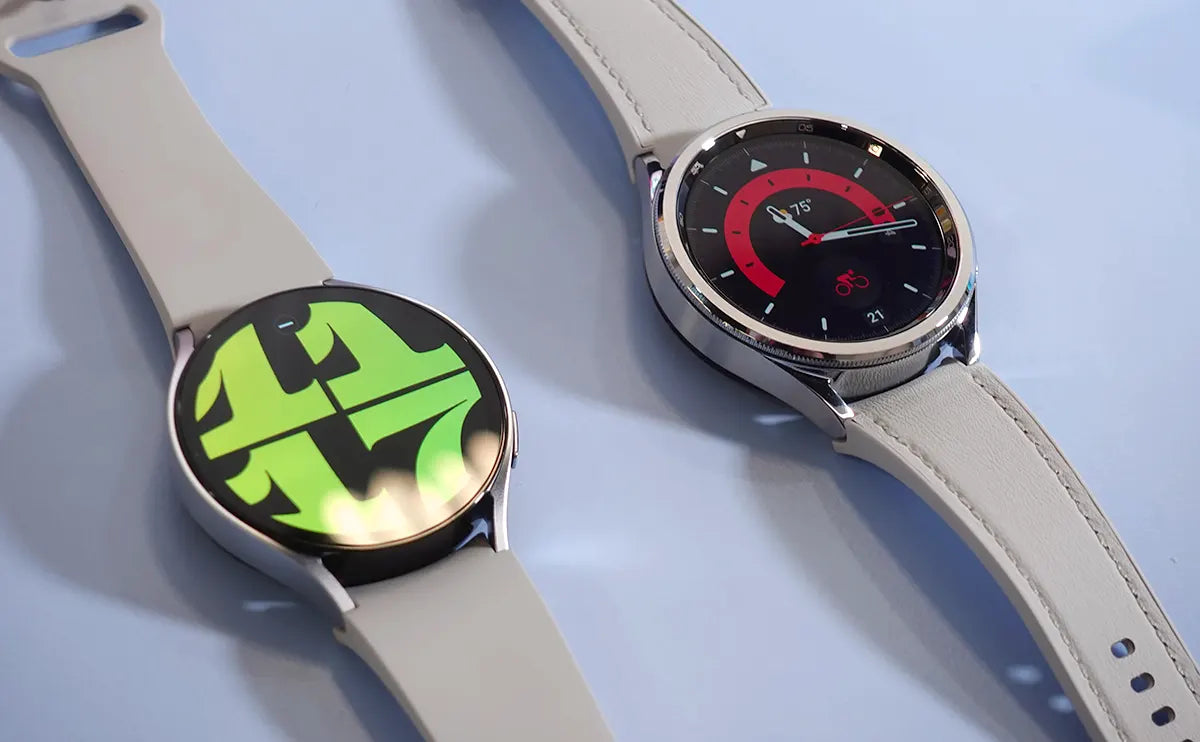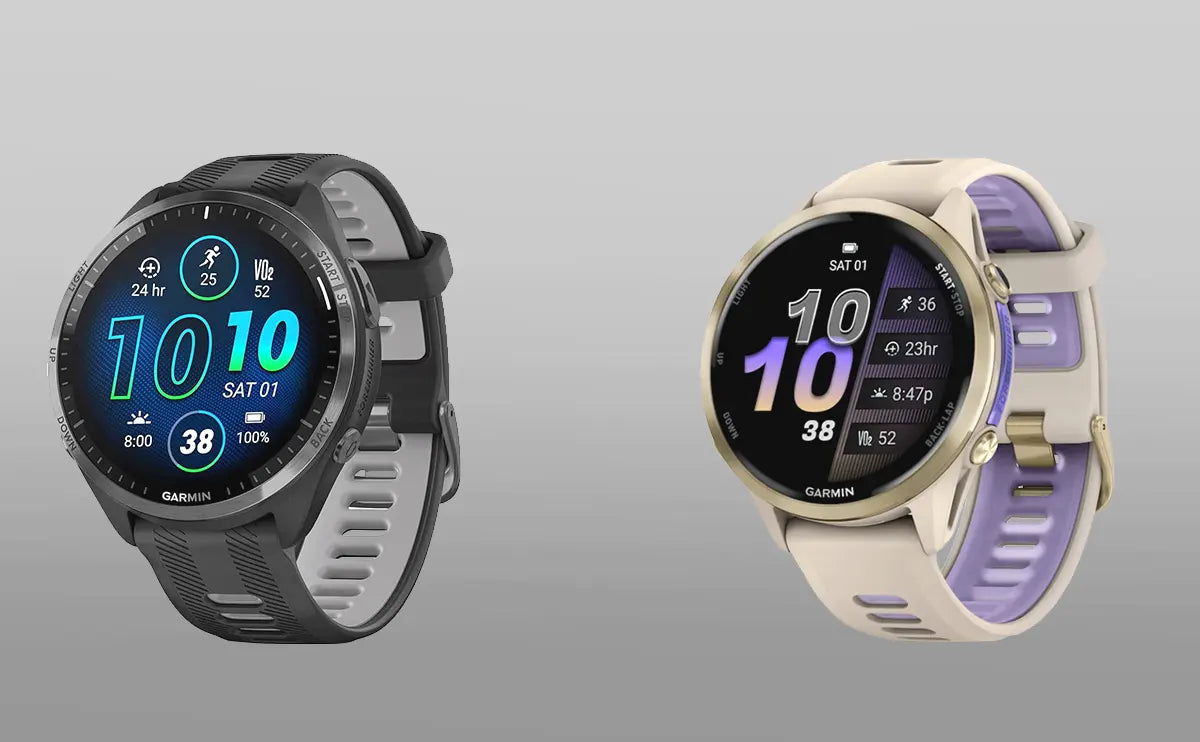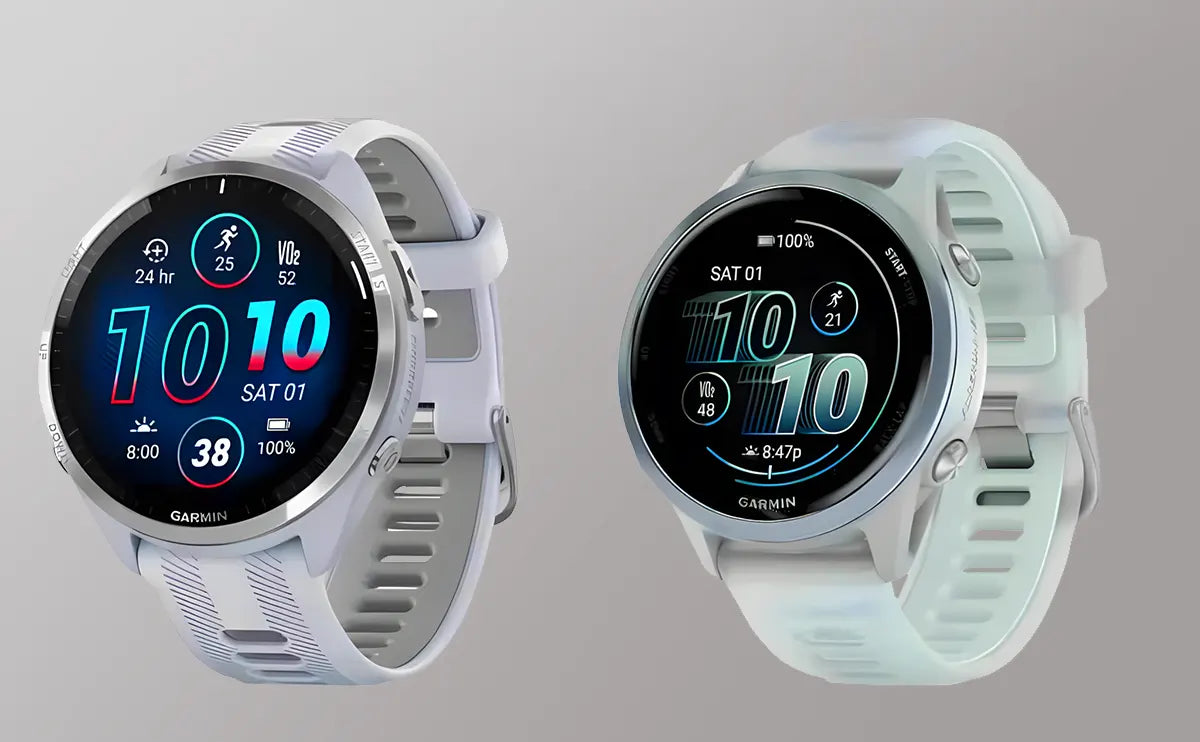Main content:
- Samsung Galaxy Watch 6 vs 7 - Similarities and Differences
- Samsung Galaxy Watch 6 vs 7 - Specifications
- Samsung Galaxy Watch 6 vs 7 - Price
- Samsung Galaxy Watch 6 vs 7 - Design, Material and Size
- Samsung Galaxy Watch 6 vs 7 - Display
- amsung Galaxy Watch 6 vs 7 - Processor and Performance
- Samsung Galaxy Watch 6 vs 7 - Health and Fitness Tracking
- Samsung Galaxy Watch 6 vs 7 - Battery Life
- Samsung Galaxy Watch 6 vs 7 - Other Features
- Buying Advice - Samsung Galaxy Watch 6 vs 7
Samsung officially launched the Galaxy Watch 7 in July 2024, once again raising the bar for smart wearable devices. While the Galaxy Watch Ultra, released at the same time, has drawn much of the spotlight, the Watch 7 still stands out with its lightweight titanium design, minimalist 1.5-inch display, the all-new Exynos W1000 chip, and impressive 36-hour battery life. Combined with advanced health features like blood pressure prediction and sleep apnea detection, it’s not just a smartwatch - it’s a personal health companion.
Meanwhile, the Galaxy Watch 6, released in 2023, remains a strong contender with its smooth performance and comprehensive fitness and wellness tracking. At first glance, the two generations may appear quite similar in design and features, but the Galaxy Watch 7 brings notable upgrades in core hardware and health technologies - especially compelling for users of the Watch 5 and earlier.
Also Read:
Garmin Venu 3 vs Samsung Galaxy Watch 6
So, what are the key differences between the Galaxy Watch 6 and Galaxy Watch 7? Is it worth the upgrade? Let’s dive in and find out.
And when it comes to personalizing your smartwatch, accessories matter. At Bandletic, we offer a wide range of high-quality Samsung watch bands to complement your device - from the latest Galaxy Watch 7 Bands, Galaxy Watch 6 bands, and Samsung Galaxy 6 Classic Watch bands to options for earlier Samsung watch bands like the Galaxy Watch 4 bands, Galaxy Watch 5 Bands, and Galaxy Watch Active Bands. We’ve also introduced Samsung Galaxy Watch Ultra Bands, ensuring a perfect fit for every generation. Whether you're dressing for the office, the gym, or anything in between, Bandletic bands are designed to match your style and lifestyle.
Samsung Galaxy Watch 6 vs 7 - Similarities and Differences
- Both offer Bluetooth and LTE versions (LTE supports SIM cards).
- Available in 40mm and 44mm sizes, with 5ATM + IP68 water and dust resistance.
- Both use dual-frequency GPS (L1 + L5) for more accurate positioning.
- Equipped with 2GB RAM and 32GB storage.
- Support voice-to-text, health tracking (heart rate, sleep, body temperature, etc.).
- Meet MIL-STD-810H military durability standards, have a 425mAh battery with similar battery life.
Differences:
- Processor: Watch 7 uses a 3nm five-core Exynos W1000 for stronger performance; Watch 6 uses a 5nm dual-core Exynos W930.
- Sensors: Watch 7 features a second-generation BioActive sensor with AI for more accurate data; Watch 6 has the first-generation sensor.
- Material and Size: Watch 7 has a 40mm armored aluminum case, lighter and more compact; Watch 6 Classic has a larger 47mm stainless steel case.
- Storage: Watch 7 offers 32GB, while Watch 6 Classic offers 16GB.
- GPS Support: Watch 7 supports dual-frequency GPS for higher precision, whereas Watch 6 Classic supports only L1 GPS.
Summary:
The Galaxy Watch 7 excels in performance and features, while the Watch 6 stands out with its classic design.
Samsung Galaxy Watch 6 vs 7 - Specifications
|
Specification |
Samsung Galaxy Watch 7 |
Samsung Galaxy Watch 6 |
|
Case Size |
40.4 × 40.4 × 9.7 mm |
38.8 × 40.4 × 9.0 mm |
|
Weight |
28.8 g |
28.7 g |
|
Operating System |
Wear OS |
Wear OS |
|
Phone Compatibility |
Android |
Android |
|
Processor |
Exynos W1000 (5-core, 3nm) |
Exynos W930 (Dual-core, 1.4GHz, 5nm) |
|
Display Size |
1.3" / 1.5" |
1.3" / 1.5" |
|
Display Type |
Super AMOLED |
AMOLED |
|
Resolution |
432 × 432 pixels |
432 × 432 pixels |
|
Storage |
32 GB |
16 GB |
|
Battery Capacity |
300 mAh |
300 mAh |
|
Battery Life |
Up to 40 hours (22 hours tested) |
Up to 40 hours (22 hours tested) |
|
Fitness Features |
GPS, Heart Rate, Blood Oxygen, Temperature, Accelerometer, Barometer, Gyroscope |
GPS, Heart Rate, Blood Oxygen, Temperature, Accelerometer, Barometer, Gyroscope |
Samsung Galaxy Watch 6 vs 7 - Price
The Galaxy Watch 6 and Galaxy Watch 7 both start at $299.99, offering two size options: 40mm and 44mm. While the pricing is identical, the available color options vary slightly. The Watch 7 comes in Green, Cream, and Silver, whereas the Watch 6 offers Graphite, Gold, and Silver.
Final pricing may vary depending on the model, connectivity option (Bluetooth or Bluetooth + 4G), and band material. Regardless of the generation, users can easily purchase either watch through official channels or authorized retailers.
Winner: Galaxy Watch 7
Reason: While maintaining the same starting price, it offers improved AI features and optional 4G connectivity, making it a better value overall.
Samsung Galaxy Watch 6 vs 7 - Design, Material and Size
The Galaxy Watch 6 and Galaxy Watch 7 share a highly similar overall design, both featuring a minimalist round case with dual-side button layout that’s sleek, understated, and naturally comfortable on the wrist. Available in 40mm and 44mm sizes, they suit a wide range of wrist sizes. Both watches are crafted from lightweight aluminum alloy, combined with refined finishing techniques to deliver a premium, comfortable feel.
In terms of detail, the Galaxy Watch 7 is slightly thicker than its predecessor and introduces a small colored accent below the top button, adding a touch of character to the design. The convenient one-click strap mechanism remains, allowing for easy band changes. Both models meet MIL-STD-810H durability standards and offer 5ATM + IP68 water and dust resistance—making them reliable for daily wear.
Winner: Tie. While the Galaxy Watch 7 brings minor refinements, both models share nearly identical design language and material quality, offering a comparable wearing experience.

Samsung Galaxy Watch 6 vs 7 - Display
There is virtually no difference between the Galaxy Watch 6 and Watch 7 in terms of display. Both models are available in 40mm and 44mm case sizes, featuring 1.3-inch and 1.5-inch Super AMOLED displays with resolutions of 432x432 and 480x480, respectively. The screens have slim bezels, offering an immersive visual experience with vibrant colors and deep blacks that remain clearly visible even under bright sunlight. Additionally, both watches adopt a slightly raised “floating” screen design, which helps reduce scratches and enhances both practicality and aesthetics.
In terms of size, brightness, and readability, both models perform almost identically, delivering a nearly identical user experience.
Winner: Draw. The Galaxy Watch 6 and Watch 7 offer the same screen size, display technology, and visual quality - making it hard to declare a clear winner.

Samsung Galaxy Watch 6 vs 7 - Processor and Performance
Samsung’s Galaxy Watch series has always used its own Exynos processors. The Galaxy Watch 7 upgrades to the Exynos W1000, featuring five cores and a 1.6GHz clock speed, significantly improving performance over the Watch 6’s Exynos W930, which has two cores and a 1.4GHz clock speed.
In terms of storage, the Watch 7 offers 32GB - double that of the Watch 6 - providing more space for music and app downloads. Both watches run a customized version of Wear OS 4 with One UI 5, delivering a stable software experience with occasional minor bugs. Samsung promises four years of system updates and five years of security updates for both watches, but due to its later release, the Watch 7 receives one additional year of support compared to the Watch 6.
Winner: Galaxy Watch 7
With a more powerful processor, larger storage, and longer software support, the Galaxy Watch 7 leads in performance.

Samsung Galaxy Watch 6 vs 7 - Health and Fitness Tracking
Samsung smartwatches have always prioritized fitness tracking. Both the Galaxy Watch 6 and Watch 7 feature the precise BioActive sensor that monitors heart rate, blood pressure, ECG, stress levels, and body composition metrics such as weight, skeletal muscle, fat, and water.
Building on this, the Watch 7 introduces an Energy Score that combines seven health metrics - including sleep quality, training history, and heart monitoring—to help users assess their daily energy levels. It also adds FDA-approved sleep apnea detection and an AGEs index, which reflects biological aging and metabolic health, enhancing the depth and breadth of health monitoring.
For sports tracking, both watches support multiple exercise modes with automatic detection, real-time tracking of steps, calories burned, and heart rate. Notably, the Galaxy Watch 7 supports dual-frequency GPS (L1 + L5), whereas the Galaxy Watch 6 Classic version supports only single-frequency L1 GPS.
This dual-frequency GPS greatly improves location accuracy and stability, especially useful for outdoor activities and navigation in complex environments. Additionally, the Watch 7 intelligently adjusts heart rate monitoring frequency based on activity to ensure accurate data, pairing this with GPS for precise route tracking and workout feedback.
Winner: Galaxy Watch 7
With more comprehensive health metrics, advanced sleep monitoring, and improved sports tracking accuracy thanks to dual-frequency GPS, the Galaxy Watch 7 clearly leads in health and fitness tracking.
Samsung Galaxy Watch 6 vs 7 - Battery Life
The Galaxy Watch 6 delivers solid battery performance, offering nearly two days of use on a single charge and supporting 10W fast charging - twice as fast as previous models.
While the Galaxy Watch 7 doesn't significantly increase battery capacity, it benefits from the new Exynos W1000 chip, which brings notable energy efficiency improvements. As a result, it can extend usage up to around 2.5 days. Charging is also faster, with just 15 minutes providing a full day of power.
Winner: Galaxy Watch 7. Thanks to enhanced power efficiency and faster charging, the Watch 7 delivers longer battery life despite similar capacity.
Samsung Galaxy Watch 6 vs 7 - Other Features
Both the Galaxy Watch 6 and Galaxy Watch 7 offer robust smart features such as voice-to-text, smart voice assistant, gesture controls (like answering calls and switching music), and real-time app notifications. They also support recording audio on the watch, which can be transcribed, translated, and summarized on a Samsung phone — enhancing productivity and convenience.
However, the Galaxy Watch 7 takes it a step further. It comes in both Bluetooth and Bluetooth + 4G versions, offering more flexible connectivity for users who prefer independent communication without relying on a smartphone. Additionally, it integrates Samsung’s latest Galaxy AI technology, enabling faster, more intelligent voice interactions and a smoother user experience overall.
Winner: Galaxy Watch 7
Reason: With stronger connectivity options and smarter AI features, it offers a more seamless and versatile everyday experience.

Buying Advice - Samsung Galaxy Watch 6 vs 7
If you’re a Galaxy Watch 6 user, upgrading isn’t necessary unless you have high demands for health monitoring and GPS accuracy. The Watch 6 still offers strong performance and smooth daily use, with many new features available through software updates. In contrast, the Galaxy Watch 7 brings improvements in processor speed, health sensors, and battery life, delivering a more seamless and intelligent user experience.
The upgrade is especially recommended for:
- High-intensity fitness enthusiasts
- People needing long-term health monitoring
- Tech enthusiasts who want the latest features
The Galaxy Watch 7 is more than just a hardware upgrade - it sets a new standard in smart wearables. It not only meets everyday needs but also serves as a reliable health companion. Although the improvements are incremental, Watch 7 is the better choice for those seeking high performance and advanced intelligence. For users of Watch 5 or earlier models, this upgrade is definitely worthwhile.






Share:
2025's Top 10 Garmin Watch Band Brands for Quality and Performance
Should You Upgrade? Apple Watch Series 6 vs 10 Full Comparison